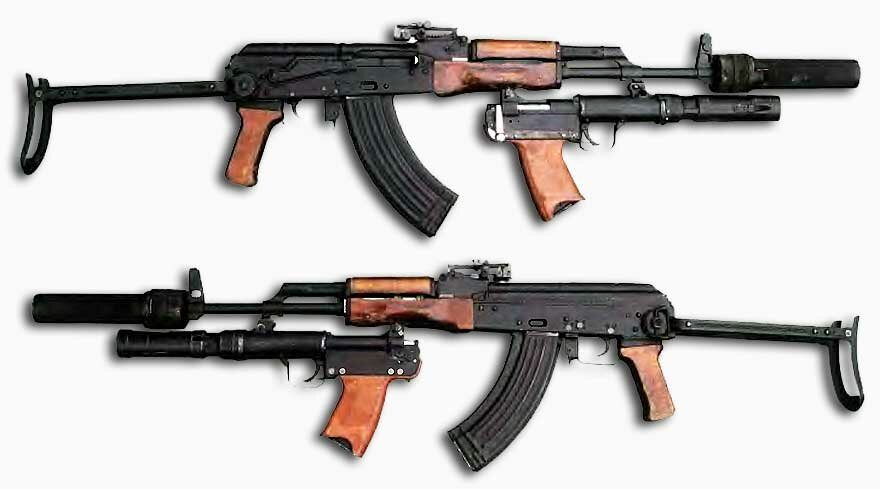7.62 mm/30 mm Tishina assault rifle/grenade launcher system

| Specifications Tishina assault rifle/grenade launcher system Caliber.....................................................................7,62/30 mm Cartridge.....................................................................7,62 x 39 Weapon weight w/o rds and w/o a grenade......................6 kg Weapon length w/unfolded stock.................................900 mm Sighting range sight........................................................300 m Grenade muzzle velocity.............................................105 m/sec Assault rifle magazine capacity........................................ 30 rds Grenade launcher magazine capacity.............10 special cartridges |
||
For certain special missions effectiveness of special small arms capable of delivering noiseless and Cashless lire with bullets proves inadequate. Such missions as damage of enemy command posts, destruction of missiles moving or stationed on launch pads, destruction of helicopters and aircraft parked on the ground, derangement of key command and control elements as well as other missions, including subversive ones, call for a more powerful weapon combining the above mentioned special properties with greater destructive power.
In the 1970s the Tishina special noiseless assault rifle/grenade launcher system was adopted for service with special operations units of the Soviet Army. The system included a special noiseless modification of the 7.62mm AKMSB assault rifle equipped with the PBS-1 silent (noiseless) and flashless faring device and a special 30mm noiseless under barrel grenade launcher.
The PSB-1 noiseless firing device is screwed on the assault rifle's threaded muzzle instead of the compensator. The device is a cylindrical chamber divided into compartments by steel disc baffles. The baffles are fastened together with three steel bracing rods. They have holes at centre allowing free passage of the bullet. The first compartment next to the muzzle face of the assault rifle barrel is separated with a solid rubber wiper 18-20 mm thick» unbroken when newly installed.
Before the wiper, there is an additional chamber with four circumferential holes for powder gases to divert into the expansion chamber near the PBS base which has another four circumferential holes in its body.
When the bullet leaves the muzzle face of the barrel, powder gases rushing after it get into the diversion chamber, and some part of them is redirected through the holes to the expansion chamber, where they lose pressure and temperature and are vented to the atmosphere. As a result, the overall pressure and temperature of the powder gases drop. Moving further, the bullet penetrates the rubber wiper whose opened edges close in under rubber resilience and hinder passing of gases expanding after the bullet. When passing through the opening in the wiper, the gases additionally lose some velocity. Powder gases that have passed through the wiper enter into the expansion chamber. There gas temperature and pressure drop and the gases break up into interfering streams owing to greater volume of the expansion chamber compared with the barrel bore, and the effect of the dividing baffles.
Thus, muzzle flash is suppressed at shooting (flashless fire mode), and the sound of shot is muted to the level usual for a weapon with silencer. The wiper opening gradually increases as the rubber wears down under high mechanical and thermal loads, being a replaceable element of the PBS-1 device. The PBS-1 weight is 640 g, length 186 mm, and the greatest diameter 53 mm.
The assault rifle equipped with the PBS-1 device fires only the US special (reduced velocity) rounds with heavy bullet having subsonic muzzle velocity. The bullet tip is painted black and circled with green border.
The 30mm under barrel noiseless grenade launcher is definitely the most outstanding component of the system. It is fixed to the lower parts of the forearm and barrel of the assault rifle with appropriate fasteners. It means that, unlike the conventional GP-25/GP-30 under barrel grenade launchers, the noiseless grenade launcher cannot be attached to any standard-type assault rifle. The grenade launcher ammunition is a 30 mm grenade with shaped charge warhead capable of piercing about 10 mm thick steel sheet. Because of the weapon's specific design (firing with powder gases cutoff), the grenade does not have its own propellant charge. The energy of powder gases of a special grenade propelling cartridge is employed. The grenade propelling round case is not elongated, unlike cases of the 7.62x39 standard assault rifle blank cartridges. The rounds are loaded in a special magazine inserted into grenade launcher pistol grip.
The grenade launcher is equipped with a rifle-type longitudinally sliding bolt which reloads grenade propelling rounds from the breech end and locks the breech. However, the grenade itself is loaded in the launcher barrel from the muzzle end, so the grenade launcher is essentially a muzzle-loaded weapon.
The grenade is held by spring-action bends in the barrel wall. Si is stabilized in flight by rotation: when grenade is loaded three ready-made protrusions on its body enter into the three twist rifling’s in the barrel bore.
When shot is fired, powder gases do not press on the grenade bottom but on a special piston which ejects the grenade out of the barrel bore and locks away (cuts off) powder gases in the chamber to ensure silent and fleshless fire. Grenade muzzle velocity is 100 m/s.
The grenade launcher s sighting device is a flip-up rack sight with sighting point aligned, when shooting, with the assault rifle standard front sight. The rack sight is mourned on the assault rifle's rear sight bed and equipped with lateral correction mechanism.
Tile assault rifle rear sight leaf is additionally equipped with a clamp with lateral correction mechanism and is designed for shooting with the US bullet rounds.
The transition to a new-calibre ammunition en the mid-1970s and adoption for service with the Soviet Army of the small arms system firing the 5.45mm round required a corresponding modernization of noiseless assault rifle/grenade launcher system as well.
However, attempts to successfully solve this problem based on the AK 74/AKS 74 assault rifles failed. With smaller calibre, relative length of assault rifle barrel considerably increased since overall weapon dimensions remained the same. As a result, the US cartridge bullets (with reduced muzzle velocity) used for noiseless shooting demonstrated unstable ballistics. Therefore, further works were conducted on the 5.45 mm AKS 74U shortened version of the assault rifle.

